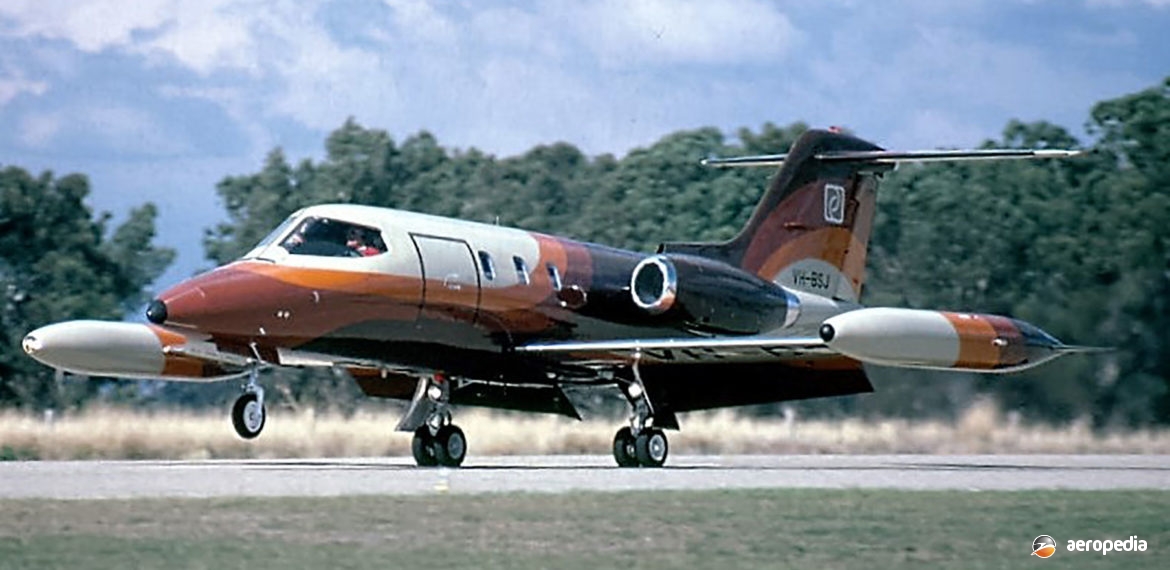Photograph:
Learjet 24D VH-BSJ (c/n 24-266) landing at Wangaratta, VIC in April 1987 (David C Eyre)
Country of origin:
United States of America
Description:
Business and executive aircraft
Power Plant:
Two 2,950 lbst General Electric CJ610-6 turbojets
Specifications:
- [24F]
- Wingspan: 10.84 m (35 ft 7 in)
- Length: 13.18 m (43 ft 3 in)
- Height: 3.73 m (12 ft 3 in)
- Wing area: 21.53 m² (231.8 sq ft)
- Never exceed speed Mach: 0.86
- Max speed at 9,450 m (31,000 ft): 877 km/h (545 mph)
- Cruising speed at 13,715 m (45,000 ft): 774 km/h (481 mph)
- Stalling speed: 161 km/h (100 mph)
- Rate of climb: 2,073 m/min (6,800 ft/min)
- Service ceiling: 13,715 m (45,000 ft)
- Empty weight: 3,324 kg (7,130 lb)
- Loaded weight: 6,123 kg (13,500 lb)
History:
For many years marketed as the fastest business jet in production, the Learjet was also the most well known and one of the best selling, with some 745 turbojet examples having been delivered in the 23, 24, 25, 28 and 29 series. Designed by William P Lear in Switzerland as the SAAC-23, the Learjet was first produced as the Learjet in Wichita, Kansas, the prototype Model 23 flying for the first time on 7 October 1963. 104 examples of this model were produced before production switched to the Model 24, this having a number of detailed improvements and up-rated engines. Successive models of the basic design appeared in the following years, these being the Models 24B, 24D, 24E and 24F, all with up-rated engines, increased fuel capacity to permit greater range, and higher maximum take-off weights.
As compared to the Model 23, the Model 24 had increased cabin pressurisation to permit higher operating levels, an additional window in the cabin, more powerful engines, a new front windshield, auxiliary fuel available in the wing tip tanks and a fire extinguishing system for the engines. It received certification under FAR-25 and an example, to publicise the type, flew around the world in 50 hours and 20 minutes.
Models available included the 24A, which permitted a take-off weight of 6,123 kg (13,499 lb) and which was certified on 9 November 1966, 81 examples being completed. The 24B was improved with 2,950 lbst CJ610-6 engines and was certified on 17 December 1968, 49 examples being completed. The 24C was a light-weight variant of the 24B, having the fuselage tank removed, thus providing a reduction in range, take-off weight to be 5,675 kg (12,511 lb) but in the event none were built.
The 24D was a model with variations in the fuel tanks, providing a take-off weight of 6,129 kg (13,512 lb). It had new design windows and was certified on 17 July 1970, 99 examples being completed. The 24D/A was a light-weight model with take-off weight restricted to 5,669 kg (12,500 lb). The Models 24E and 24F were introduced in 1976 and had a new cambered wing and aerodynamic improvements to reduce the stalling speed. The 24E had the fuselage fuel tank and CJ610-8A engines. In April 1977 it was approved to have a ceiling of 16,000 m (51,000 ft). Only 29 aircraft were delivered.
A number of Learjet 24s and 25s have been registered in Australia over the years. A Model 24D became VH-BSJ (c/n 266) on 8 September 1973 to BS Stillwell and Company, having a number of owners over the years including Hancock Prospecting Pty Ltd, Capitol Motors Ltd, Arnjul Pty Ltd, Sundowner Investments and Jet City Pty Ltd, before being exported in November 1996 as N266BS.
Model 24D VH-SBC (c/n 279) was registered on 20 December 1973 to SBC Transport Pty Ltd. Subsequent owners included Swan Hotels Pty Ltd, Rampside Pty Ltd and BS Stillwell & Company Pty Ltd, before it was exported to the United States as N3DU in September 1979.
A Model 24F became VH-FLJ (c/n 349) to Barclay Bros Pty Ltd on 3 December 1977. Subsequent owner was BS Stillwell Aviation (Australasia) Pty Ltd and it was exported to the United States as N349BS on 29 January 1980.
A Learjet 24XR (c/n 24-319N174RD) arrived at Camden, NSW in January 2005 and was cancelled from the US civil aircraft register on 19 August 2010 as being exported to Australia. The aircraft was built in 1975 as a standard 24D and was modified to 24XR configuration, this indicating an aerodynamics upgrade package carried out by Dee Howard. However, the aircraft has never been placed on the Australian register and on 23 September 2013 it was placed back on the US register as N174RD. The aircraft remained at Camden and in February 2018 was not known to have been flown again in Australia, although on a number of occasions work had been undertaken on it to prepare it for flight.

